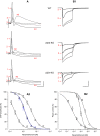The role of the nAChR subunits α5, β2, and β4 on synaptic transmission in the mouse superior cervical ganglion
- PMID: 30891952
- PMCID: PMC6424856
- DOI: 10.14814/phy2.14023
The role of the nAChR subunits α5, β2, and β4 on synaptic transmission in the mouse superior cervical ganglion
Abstract
Our previous immunoprecipitation analysis of nicotinic acetylcholine receptors (nAChRs) in the mouse superior cervical ganglion (SCG) revealed that approximately 55%, 24%, and 21% of receptors are comprised of α3β4, α3β4α5, and α3β4β2 subunits, respectively. Moreover, mice lacking β4 subunits do not express α5-containing receptors but still express a small number of α3β2 receptors. Here, we investigated how synaptic transmission is affected in the SCG of α5β4-KO and α5β2-KO mice. Using an ex vivo SCG preparation, we stimulated the preganglionic cervical sympathetic trunk and measured compound action potentials (CAPs) in the postganglionic internal carotid nerve. We found that CAP amplitude was unaffected in α5β4-KO and α5β2-KO ganglia, whereas the stimulation threshold for eliciting CAPs was significantly higher in α5β4-KO ganglia. Moreover, intracellular recordings in SCG neurons revealed no difference in EPSP amplitude. We also found that the ganglionic blocking agent hexamethonium was the most potent in α5β4-KO ganglia (IC50 : 22.1 μmol/L), followed by α5β2-KO (IC50 : 126.7 μmol/L) and WT ganglia (IC50 : 389.2 μmol/L). Based on these data, we estimated an IC50 of 568.6 μmol/L for a receptor population consisting solely of α3β4α5 receptors; and we estimated that α3β4α5 receptors comprise 72% of nAChRs expressed in the mouse SCG. Similarly, by measuring the effects of hexamethonium on ACh-induced currents in cultured SCG neurons, we found that α3β4α5 receptors comprise 63% of nAChRs. Thus, in contrast to our results obtained using immunoprecipitation, these data indicate that the majority of receptors at the cell surface of SCG neurons consist of α3β4α5.
Keywords: EPSP; Compound action potential; Hexamethonium; knockout mice; nicotinic ACh receptor; superior cervical ganglion; synaptic transmission.
© 2019 The Authors. Physiological Reports published by Wiley Periodicals, Inc. on behalf of The Physiological Society and the American Physiological Society.
Conflict of interest statement
None declared.
Figures






Similar articles
-
α4β2 nicotinic acetylcholine receptors in the early postnatal mouse superior cervical ganglion.Dev Neurobiol. 2011 May;71(5):390-9. doi: 10.1002/dneu.20870. Dev Neurobiol. 2011. PMID: 21485013 Free PMC article.
-
Biochemical and functional properties of distinct nicotinic acetylcholine receptors in the superior cervical ganglion of mice with targeted deletions of nAChR subunit genes.Eur J Neurosci. 2010 Mar;31(6):978-93. doi: 10.1111/j.1460-9568.2010.07133.x. Epub 2010 Mar 3. Eur J Neurosci. 2010. PMID: 20377613 Free PMC article.
-
Heterogeneity of nicotinic cholinergic receptors in rat superior cervical and nodose Ganglia.Mol Pharmacol. 2006 Nov;70(5):1693-9. doi: 10.1124/mol.106.027458. Epub 2006 Aug 1. Mol Pharmacol. 2006. PMID: 16882879
-
Nicotinic acetylcholine receptors in autonomic ganglia.Auton Neurosci. 2002 Apr 18;97(1):1-11. doi: 10.1016/s1566-0702(01)00386-1. Auton Neurosci. 2002. PMID: 12036180 Review.
-
Reactive oxygen species inactivate neuronal nicotinic acetylcholine receptors through a highly conserved cysteine near the intracellular mouth of the channel: implications for diseases that involve oxidative stress.J Physiol. 2012 Jan 1;590(1):39-47. doi: 10.1113/jphysiol.2011.214007. Epub 2011 Oct 3. J Physiol. 2012. PMID: 21969449 Free PMC article. Review.
Cited by
-
Nicotinic Acetylcholine Receptor Partial Antagonist Polyamides from Tunicates and Their Predatory Sea Slugs.ACS Chem Neurosci. 2021 Jul 21;12(14):2693-2704. doi: 10.1021/acschemneuro.1c00345. Epub 2021 Jul 2. ACS Chem Neurosci. 2021. PMID: 34213884 Free PMC article.
-
The α5 Nicotinic Acetylcholine Receptor Subunit Differentially Modulates α4β2* and α3β4* Receptors.Front Synaptic Neurosci. 2020 Dec 3;12:607959. doi: 10.3389/fnsyn.2020.607959. eCollection 2020. Front Synaptic Neurosci. 2020. PMID: 33343327 Free PMC article. Review.
-
PeIA-5466: A Novel Peptide Antagonist Containing Non-natural Amino Acids That Selectively Targets α3β2 Nicotinic Acetylcholine Receptors.J Med Chem. 2019 Jul 11;62(13):6262-6275. doi: 10.1021/acs.jmedchem.9b00566. Epub 2019 Jun 27. J Med Chem. 2019. PMID: 31194549 Free PMC article.
-
Loss of Cervical Sympathetic Chain Input to the Superior Cervical Ganglia Affects the Ventilatory Responses to Hypoxic Challenge in Freely-Moving C57BL6 Mice.Front Physiol. 2021 Apr 22;12:619688. doi: 10.3389/fphys.2021.619688. eCollection 2021. Front Physiol. 2021. PMID: 33967819 Free PMC article.
-
Therapeutic potential of α7 nicotinic acetylcholine receptor agonists to combat obesity, diabetes, and inflammation.Rev Endocr Metab Disord. 2020 Dec;21(4):431-447. doi: 10.1007/s11154-020-09584-3. Epub 2020 Aug 26. Rev Endocr Metab Disord. 2020. PMID: 32851581 Free PMC article. Review.
References
-
- Bowers, C. W. , and Zigmond R. E.. 1979. Localization of neurons in the rat superior cervical ganglion that project into different postganglionic trunks. J. Comp. Neurol. 185:381–391. - PubMed
Publication types
MeSH terms
Substances
Grants and funding
LinkOut - more resources
Full Text Sources
Molecular Biology Databases
Research Materials
Miscellaneous

